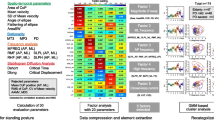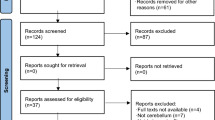Abstract
We examined the interaction between the control of posture and an aiming movement. Balance control was varied by having subjects aim at a target from a seated or a standing position. The aiming difficulty was varied using a Fitts’-like paradigm (movement amplitude=30 cm; target widths=0.5, 1.0, 2.5 and 5 cm). For both postural conditions, all targets were within the reaching space in front of the subjects and kept at a fixed relative position with respect to the subjects’ body. Hence, for a given target size, the aiming was differentiated only by the postural context (seated vs. upright standing). For both postural conditions, movement time (MT) followed the well-known Fitts’ law, that is, it increased with a decreasing target size. For the smallest target width, however, the increased MT was greater when subjects were standing than when they were seated suggesting that the difficulty of the aiming task could not be determined solely by the target size. When standing, a coordination between the trunk and the arm was observed. Also, as the target size decreased, the center of pressure (CP) displacement increased without any increase in CP speed suggesting that the subjects were regulating their CP to provide a controlled referential to assist the hand movement. When seated, the CP kinematics was scaled with the hand movement kinematics. Increasing the index of difficulty led to a strong correlation between the hand speed and CP displacement and speed. The complex organization between posture and movement was revealed only by examining the specific interactions between speed–accuracy and postural constraints.







Similar content being viewed by others
References
Arbib MA (1985) Brain theory and cooperative computation. Hum Neurobiol 4:201–218
Archambault P, Pigeon P, Feldman AG, Levin MF (1999) Recruitment and sequencing of different degrees of freedom during pointing movements involving the trunk in healthy and hemiparetic subjects. Exp Brain Res 126:55–67
Bouisset S, Zattara M (1981) A sequence of postural movements precedes voluntary movements. Neurosci Lett 22:263–270
Bouisset S, Richardson J, Zattara M (2000) Do anticipatory postural adjustments occurring in different segments of the postural chain follow the same organisational rule for different task movement velocities, independently of the inertial load value? Exp Brain Res 132:79–86
Bourdin C, Teasdale N, Nougier V (1998) Complex postural constraints affect the organization of reaching and grasping movements. Exp Brain Res 122:253–259
Brown JE, Frank JS (1987) Influence of event anticipation on postural actions accompanying voluntary movement. Exp Brain Res 67:645–650
Crenna P, Frigo C, Massion J, Pedotti A (1987) Forward and backward axial synergies in man. Exp Brain Res 65:538–548
Crosbie J, Sheperd R, Squire T (1995) Postural and voluntary movement during reaching in sitting: The role of the lower limbs. J Hum Mov Stud 28:103–126
Dounskaia N, Wisleder D, Johnson T (2005) Influence of biomechanical factors on substructure of pointing movements. Exp Brain Res 164:505–516
Dufosse M, Hugon M, Massion J (1985) Postural forearm changes induced by predictable in time or voluntary triggered unloading in man. Exp Brain Res 60:330–334
Fitts PM (1954) The information capacity of the human motor system controlling the amplitude of the movement. J Exp Psychol 47:381–391
Fitts PM, Peterson JR (1964) Information capacity of discrete motor responses. J Exp Psychol 67:103–112
Henry FM, Rogers DE (1960) Increased response latency for complicated movements and a “memory drum” theory of neuromotor reaction. Res Q 31:448–457
Horak FB, Esselman P, Anderson ME, Lynch MK (1984) The effects of movement velocity, mass displaced, and task certainty on associated postural adjustments made by normal and hemiplegic individuals. J Neurol Neurosurg Psychiatry 47:1020–1028
Jagacinski RJ, Ward SL, Moran MS (1980) A test of Fitts’law with moving targets. Hum Factors 22:225–233
Kaminski TR, Simpkins S (2001) The effects of stance configuration and target distance on reaching. I. Movement preparation. Exp Brain Res 136:439–446
Kaminski TR, Bock C, Gentile AM (1995) The coordination between trunk and arm motion during pointing movements. Exp Brain Res 106:457–466
Kugler PN, Turvey MT (1987) Information, natural law and the self-assembly of rhythmic movement. Erlbaum, Hillsdale
Lee WA, Buchanan TS, Rodgers MW (1987) Effects of arm acceleration and behavioral conditions on the organization of postural adjustments during arm flexion. Exp Brain Res 66:257–270
Ma S, Feldman AG (1995) Two functionally different synergies during arm reaching movements involving the trunk. J Neurophysiol 73:2120–2122
Mackenzie CL, Marteniuk RG (1985) Motor skill: feedback, knowledge, and structural issues. Can J Psychol 39:313–337
Mackenzie CL, Marteniuck RG, Dugas C, Liske D, Eickmeier B (1987) Three dimensional movement trajectories in Fitts’ task: implications for control. Q J Exp Psychol 39:629–647
Marteniuk RG, Bertram CP (2001) Contributions of gait and trunk movements to prehension: perspectives from world- and body-centered coordinates. Motor Control 5:151–165
Marteniuk RG, MacKenzie CL, Jeannerod M, Athenes S, Dugas C (1987) Constraints on human arm movement trajectories. Can J Psychol 41:365–378
Marteniuk RG, Ivens CJ, Bertram CP (2000) Evidence of motor equivalence in a pointing task involving locomotion. Motor Control 4:165–184
Martin O, Teasdale N, Simoneau M, Corbeil P, Bourdin C (2000) Pointing to a target from an upright position; tuning of postural responses when there is target uncertainty. Neurosci Lett 281:53–56
Massion J (1992) Movement, posture and equilibrium: interaction and coordination. Prog Neurobiol 38:35–56
Massion J, Alexandrov A, Frolov A (2004) Why and how are posture and movement coordinated? Prog Brain Res 143:13–27
Meyer DE, Smith JEK, Wrigth CE (1982) Models for the speed and accuracy of aimed movements. Psychol Rev 89:449–482
Mohagheghi AA, Anson JG (2002) Amplitude and target diameter in motor programming of discrete, rapid aimed movements: Fitts and Peterson (1964) and Klapp (1975) revisited. Acta Psychol (Amst) 109:113–136
Mouchnino L, Aurenty R, Massion J, Pedotti A (1992) Coordination between equilibrium and head-trunk orientation during leg movement: a new strategy build up by training. J Neurophysiol 67:1587–1598
Newell KM (1989) On task and theory specificity. J Mot Behav 21:92–96
Paillard J (1982) The contribution of peripheral and central vision to visually guided reaching. In: Ingle DJ, Goodale MA, Mansfield RJW (eds) Analyse of visual behavior. The MIT Press, Cambridge, pp 367–385
Plamondon R, Alimi AM (1997) Speed/accuracy trade-offs in target-directed movements. Behav Brain Sci 20:279–303
Pozzo T, Stapley PJ, Papaxanthis C (2002) Coordination between equilibrium and hand trajectories during whole body pointing movements. Exp Brain Res 144:343–350
Prablanc C, Echallier JF, Jeannerod M, Komilis E (1979) Optimal responses of eye and hand motor systems in pointing at a visual target. II. Static and dynamic visual cues in the control of hand movements. Biol Cybern 35:113–124
Rosenbaum DA, Meulenbroek RG, Vaughan J (2001) Planning reaching and grasping movements: theoretical premises and practical implications. Motor Control 5:99–115
Saltzman E, Scott Kelso JA (1987) Skilled actions: a task-dynamic approach. Psychol Rev 94:84–106
Schmidt RA, Zelaznick HN, Hawkins B, Frank JS, Quinn JT (1979) Motor-output variability: a theory for the accuracy of rapid motor acts. Psychol Res 86:415–451
Sidaway B, Christina RW, Shea JB (1988) A movement constraint interpretation of the response complexity effect on programming time. In: Colley AM, Beech JR (eds) Cognition and action in skilled behaviour. Elsevier, Amsterdam, pp 87–102
Soechting J (1984) Effect of target size on spatial and temporal characteristics of a pointing movement in man. Exp Brain Res 54:121–132
Teasdale N, Stelmach GE (1988) Movement disorders: the importance of the movement context. J Mot Behav 20:186–191
Wang J, Stelmach GE (1998) Coordination among the body segments during reach-to-grasp action involving the trunk. Exp Brain Res 123:346–350
Worringham CJ (1991) Variability effects on the internal structure of rapid aiming movements. J Mot Behav 23:75–85
Acknowledgements
The study was supported in part by NSERC-Canada (NT and MS) and a Jacques Cartier Association cooperative grant (NT and OM). Special thanks to Marcel Kaszap and Gilles Bouchard for programming and technical expertise.
Author information
Authors and Affiliations
Corresponding author
Rights and permissions
About this article
Cite this article
Berrigan, F., Simoneau, M., Martin, O. et al. Coordination between posture and movement: interaction between postural and accuracy constraints. Exp Brain Res 170, 255–264 (2006). https://doi.org/10.1007/s00221-005-0210-z
Received:
Accepted:
Published:
Issue Date:
DOI: https://doi.org/10.1007/s00221-005-0210-z




